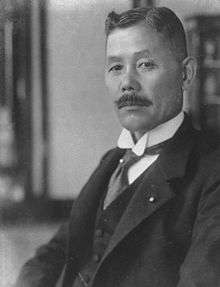Wakatsuki Reijirō
| Wakatsuki Reijirō | |
|---|---|
| 若槻 礼次郎 | |
 | |
| 25th and 28th Prime Minister of Japan | |
|
In office 14 April 1931 – 13 December 1931 | |
| Monarch | Shōwa |
| Preceded by | Hamaguchi Osachi |
| Succeeded by | Inukai Tsuyoshi |
|
In office 28 January 1926 – 20 April 1927 Acting until 30 January 1926 | |
| Monarch |
Taishō Hirohito (Regent)/Shōwa |
| Preceded by | Katō Takaaki |
| Succeeded by | Tanaka Giichi |
| Personal details | |
| Born |
21 March 1866 Matsue, Izumo Province, Japan |
| Died |
20 November 1949 (aged 83) Tokyo, Japan |
| Resting place | Somei Cemetery, Tokyo |
| Political party | Rikken Minseitō (1927–1949) |
| Other political affiliations |
Rikken Dōshikai (until 1916) Kenseikai (1916–1927) |
| Alma mater | Tokyo Imperial University |
| Signature |
 |
Baron Wakatsuki Reijirō (若槻 禮次郎, 21 March 1866 – 20 November 1949) was a Japanese politician and the 25th and 28th Prime Minister of Japan.
Early life
Wakatsuki was born in Matsue, Izumo Province, (present day Shimane Prefecture). His father, a samurai who served the local Matsudaira daimyō had the family name of Okamura. Wakatsuki was adopted after marriage into the family of his wife, since that family had no male heir, and only assumed the Wakatsuki name at that time. He enrolled in the Tokyo Imperial University in 1892 and studied law.
Political career
After graduation, Wakatsuki worked in the Ministry of Finance as tax bureau director and later as vice-minister. In 1911 he was appointed to the House of Peers. He then served as Minister of Finance under the 3rd Katsura administration and 2nd Ōkuma administration in the early 1910s and became a leading member of the Rikken Dōshikai political party, and its successor the Kenseikai, in 1914.
In June 1924, Wakatsuki was named Home Minister in the cabinet of Prime Minister Katō Takaaki, and worked to enact the Universal Manhood Suffrage Law and the Peace Preservation Law in 1925.
As Prime Minister
On 30 January 1926, on Katō's unexpected death in office, Wakatsuki took over as Prime Minister of Japan. His first term lasted to 20 April 1927 when he was forced to resign during the Shōwa financial crisis.
Wakatsuki was awarded the Order of the Paulownia Flowers on November 10, 1928. After serving as chief delegate plenipotentiary to the London Naval Conference, Wakatsuki pushed strongly for speedy ratification of the disarmament treaty, thus earning the wrath of the Japanese military and various ultranationalist groups.
After Prime Minister Hamaguchi was forced out of office by the severe injuries incurred in an assassination attempt, Wakatsuki assumed the leadership of the Rikken Minseitō, the successor to the Kenseikai. He was elevated to the rank of baron (danshaku) in the kazoku peerage system in April 1931. Wakatsuki once again became Prime Minister from 14 April 1931 to 13 December 1931. During Wakatsuki’s second term, he failed to control the Imperial Japanese Army. He was unable either to prevent the Manchurian Incident from occurring, or to rein in the Army from further escalation of hostilities in China afterwards.
Later life
After his retirement as Prime Minister, Wakatsuki became president of the Rikken Minseitō in July 1934. Despite the growing militarism in society, he continued to strongly opposed the Second Sino-Japanese War and was adamantly opposed to extending the war to include the United States and other western powers. Even after the declaration of hostilities in World War II, he publicly stated the war should end as quickly as possible. In May 1945, on hearing of the collapse of Nazi Germany, he emerged from retirement to urge Prime Minister Kantarō Suzuki to open negotiations with the United States as soon as possible. In August, he participated in the government panel recommending unconditional acceptance of the Potsdam Declaration.
After the surrender of Japan, Wakatsuki was subpeonaed by the Supreme Commander of the Allied Powers in June 1946 as a prosecution witness at The International Military Tribunal for the Far East. Wakatsuki died of Angina pectoris at his summer home in Itō, Shizuoka on November 20, 1949. His grave is at the Somei Cemetery in downtown Tokyo.[1]
Honours
From the corresponding article in the Japanese Wikipedia
- Grand Cordon of the Order of the Rising Sun with Paulownia Flowers (10 November 1928)
- Baron (11 April 1931)
See also
References
- Bix, Herbert P. (2000). Hirohito and the Making of Modern Japan. New York: HarperCollins. ISBN 978-0-06-019314-0; OCLC 247018161
- Brendon, Piers. The Dark Valley: A Panorama of the 1930s. Vintage; Reprint edition (2002). ISBN 0-375-70808-1
- Jansen, Marius B. (2000). The Making of Modern Japan. Cambridge: Harvard University Press. ISBN 9780674003347; OCLC 44090600
- Toland, John. The Rising Sun: The Decline and Fall of the Japanese Empire, 1936–1945. Modern Library; Reprint edition (2003). ISBN 0-8129-6858-1
Notes
| Wikimedia Commons has media related to Reijirō Wakatsuki. |
| Political offices | ||
|---|---|---|
| Preceded by Katō Takaaki |
Prime Minister of Japan 30 January 1926 – 20 April 1927 |
Succeeded by Tanaka Giichi |
| Preceded by Hamaguchi Osachi |
Prime Minister of Japan (acting) 28 January 1931 – 30 January 1931 |
Succeeded by Inukai Tsuyoshi |
| Preceded by Mizuno Rentarō |
Home Minister 11 June 1924 – 3 Junuary 1926 |
Succeeded by Hamaguchi Osachi |
| Preceded by Yamamoto Tatsuo |
Ministry of Finance 21 December 1912 – 20 February 1913 |
Succeeded by Takahashi Korekiyo |
| Preceded by Takahashi Korekiyo |
Ministry of Finance 16 April 1914 – 10 August 1915 |
Succeeded by Taketomi Tomitoshi |
| Preceded by Shūjirō Hara |
Minister of Colonial Affairs (acting) 10 September 1931 – 13 December 1931 |
Succeeded by Toyosuke Hata |